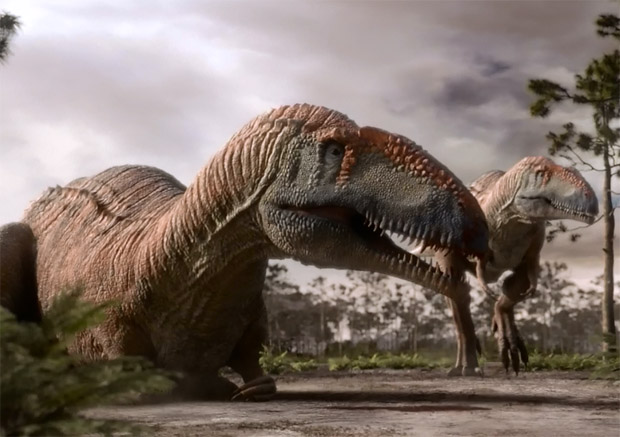Post by dinosauria101 on Jun 11, 2019 17:34:45 GMT 5
Siats meekerorum
Siats is an extinct genus of large neovenatorid theropod dinosaur known from the Late Cretaceous Cedar Mountain Formation of Utah, USA. It contains a single species, Siats meekerorum. S. meekerorum is the first neovenatorid discovered in North America and represents the geologically youngest allosauroid yet discovered from the continent. The holotype came from a single immature individual, based on its incompletely fused neural arches to their centra in the vertebral column. The taxon is characterized by seven diagnostic (including four autapomorphies) features which include the broad neural spines on the dorsal vertebrae and the subtriangular crosssection of the distal caudal vertebrae, with the latter being an autapomorphy. The discovery of this neovenatorid also reveals that tyrannosauroids did not begin to dominate North America until the late cretaceous due to the presence of allosauroids such as Siats. Siats represents the third largest theropod from North America, after Acrocanthosaurus and Tyrannosaurus. Weight?? "At 24 feet (7.3 meters) long and weighing about 2.5 tons, the 80-million-year-old Lythronax (pronounced LYE-thro-nax) lacked the even-more-massive size of T. rex, says the University of Utah's Mark Loewen, who headed the team reporting the dinosaur's discovery in PLOS One." A adult would have presumably been larger.
NOTE: Siats was probably a tyrannosauroid instead of an allosauroid, and would've likely weighed about 6 tons as an adult

Mapusaurus roseae
Mapusaurus ("Earth lizard") was a giant carnosaurian, Carcharodontosaurid dinosaur from the early Late Cretaceous (late Cenomanian to early Turonian stage) of what is now Argentina and possibly Chile. It was roughly similar in size to its close relative Giganotosaurus, averaging about 12.4 meters and 7 tons and getting to 13.6 meters long and 8.5 tons at maximum. The longest individual for which Coria and Currie (2006) provided a concrete estimate in Table 1 (apendix lll) is the animal to which femur MCF-PVPH-208.203 belonged; this individual is estimated as 10.2 metres (33 ft) long, but it is a juvenile. The fossil remains of Mapusaurus were discovered in a bone bed containing at least seven individuals of various growth stages. Coria and Currie speculated that this may represent a long term, possibly coincidental accumulation of carcasses (some sort of predator trap) and may provide clues about Mapusaurus behavior. Other known theropod bone beds include the Allosaurus-dominated Cleveland-Lloyd Dinosaur Quarry of Utah, an Albertosaurus bone bed from Alberta and a Daspletosaurus bone bed from Montana. Paleontologist Rodolfo Coria, of the Museo Carmen Funes, contrary to his published article, repeated in a press-conference earlier suggestions that this congregation of fossil bones may indicate that Mapusaurus hunted in groups and worked together to take down large prey, such as the immense sauropod Argentinosaurus. If so, this would be the first substantive evidence of gregarious behavior by large theropods other than Tyrannosaurus, although whether they might have hunted in organized packs (as wolves do) or simply attacked in a mob, is unknown.

Credit to Wikipedia
Siats is an extinct genus of large neovenatorid theropod dinosaur known from the Late Cretaceous Cedar Mountain Formation of Utah, USA. It contains a single species, Siats meekerorum. S. meekerorum is the first neovenatorid discovered in North America and represents the geologically youngest allosauroid yet discovered from the continent. The holotype came from a single immature individual, based on its incompletely fused neural arches to their centra in the vertebral column. The taxon is characterized by seven diagnostic (including four autapomorphies) features which include the broad neural spines on the dorsal vertebrae and the subtriangular crosssection of the distal caudal vertebrae, with the latter being an autapomorphy. The discovery of this neovenatorid also reveals that tyrannosauroids did not begin to dominate North America until the late cretaceous due to the presence of allosauroids such as Siats. Siats represents the third largest theropod from North America, after Acrocanthosaurus and Tyrannosaurus. Weight?? "At 24 feet (7.3 meters) long and weighing about 2.5 tons, the 80-million-year-old Lythronax (pronounced LYE-thro-nax) lacked the even-more-massive size of T. rex, says the University of Utah's Mark Loewen, who headed the team reporting the dinosaur's discovery in PLOS One." A adult would have presumably been larger.
NOTE: Siats was probably a tyrannosauroid instead of an allosauroid, and would've likely weighed about 6 tons as an adult

Mapusaurus roseae
Mapusaurus ("Earth lizard") was a giant carnosaurian, Carcharodontosaurid dinosaur from the early Late Cretaceous (late Cenomanian to early Turonian stage) of what is now Argentina and possibly Chile. It was roughly similar in size to its close relative Giganotosaurus, averaging about 12.4 meters and 7 tons and getting to 13.6 meters long and 8.5 tons at maximum. The longest individual for which Coria and Currie (2006) provided a concrete estimate in Table 1 (apendix lll) is the animal to which femur MCF-PVPH-208.203 belonged; this individual is estimated as 10.2 metres (33 ft) long, but it is a juvenile. The fossil remains of Mapusaurus were discovered in a bone bed containing at least seven individuals of various growth stages. Coria and Currie speculated that this may represent a long term, possibly coincidental accumulation of carcasses (some sort of predator trap) and may provide clues about Mapusaurus behavior. Other known theropod bone beds include the Allosaurus-dominated Cleveland-Lloyd Dinosaur Quarry of Utah, an Albertosaurus bone bed from Alberta and a Daspletosaurus bone bed from Montana. Paleontologist Rodolfo Coria, of the Museo Carmen Funes, contrary to his published article, repeated in a press-conference earlier suggestions that this congregation of fossil bones may indicate that Mapusaurus hunted in groups and worked together to take down large prey, such as the immense sauropod Argentinosaurus. If so, this would be the first substantive evidence of gregarious behavior by large theropods other than Tyrannosaurus, although whether they might have hunted in organized packs (as wolves do) or simply attacked in a mob, is unknown.

Credit to Wikipedia



